See the most detailed map of human brain matter ever created
Explore the tiny ‘pizza slice’ down to the neuron.
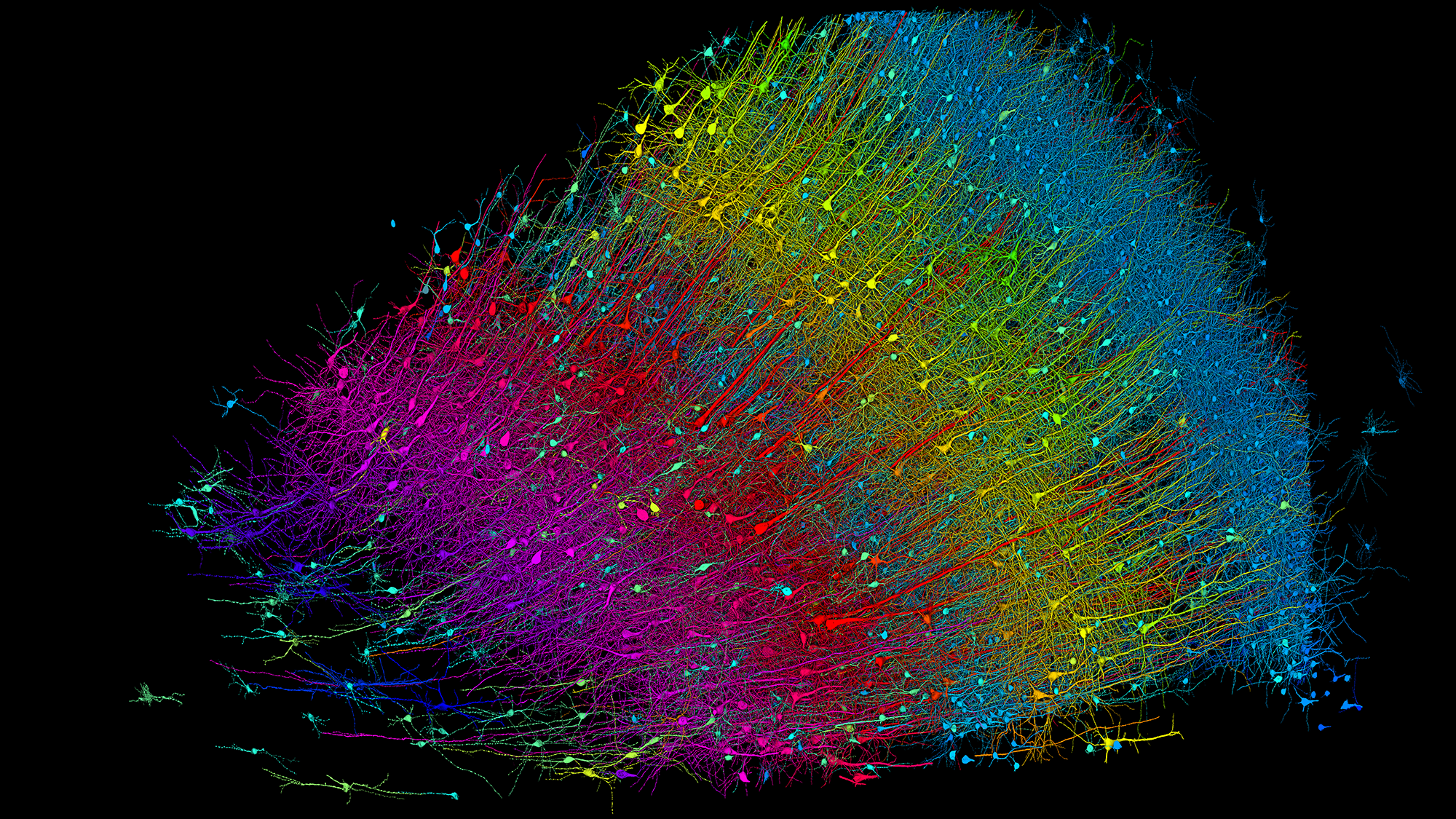
Researchers built a 3D image of nearly every neuron and its connections within a small piece of human brain tissue. This version shows excitatory neurons colored by their depth from the surface of the brain. Blue neurons are those closest to the surface, and fuschia marks the innermost layer. The sample is approximately 3 mm wide.
A cubic millimeter is, by all accounts, tiny. It’s barely noticeable–a speck or fleck or crumb. But look closely enough and you can uncover an entire world inside a particle of material. A team of neuroscientists and engineers, aided by machine learning tools, have charted a cubic millimeter volume of the human brain at nanoscale resolution, tracing every neuron, synapse, blood vessel, and supporting cell within the fragment and reconstructing a 3D model of the tissue. Though it represents just one-millionth of the total brain volume, it is the most detailed map of a piece of human brain matter ever created. It could spur a wave of scientific discovery about neurological disorders, brain structure, and the origins of our behavior.
“In one respect, our data set is miniscule,” Jeff Licthman, co-senior study researcher and a neuroscientist and professor of molecular and cellular biology at Harvard University, tells PopSci. “But it doesn’t feel small because when you get in it, you see it’s like a gigantic forest. It’s a very tiny forest, but it’s a very, very, very complicated forest,” he adds.
A single neuron (white) shown with 5,600 of the axons (blue) that connect to it. The synapses that make these connections are shown in green. The cell body (central core) of the neuron is about 14 micrometers across. Credit: Google Research & Lichtman Lab (Harvard University). Renderings by D. Berger (Harvard University)
All that complexity is on display in a study documenting the construction of this bit of comprehensive brain map or “connectome,” published May 9 in the journal Science. The first connectome was of a nematode brain, completed in 1986. Since then, neuroscientists have continued to plot out increasingly large and complicated brains–including those of fruit flies, maggots, a tadpole, and an earthworm. Yet human brains pose a unique mapping challenge in their intricacy and inaccessibility. The new, partial human connectome is available online for anyone to explore.
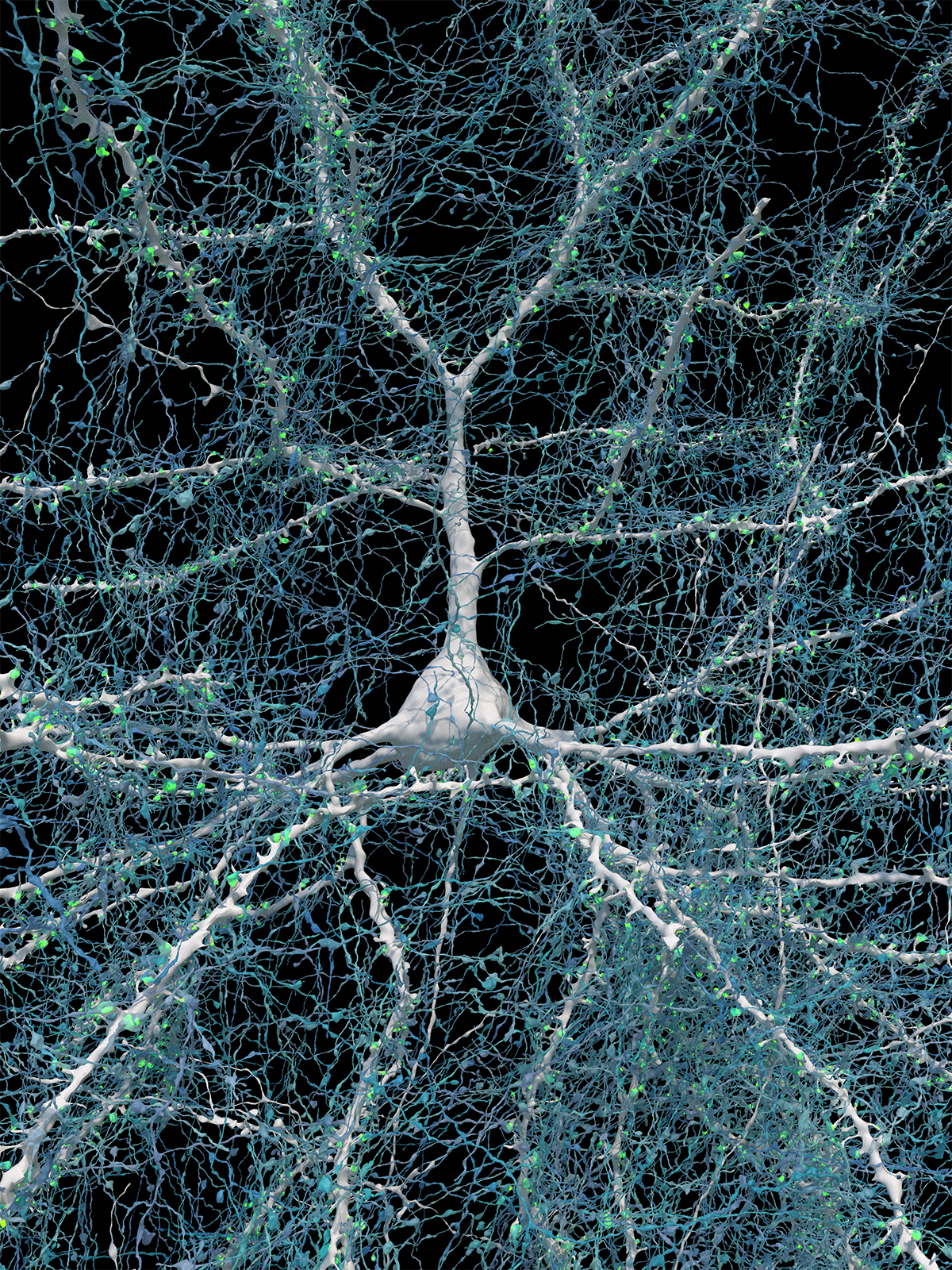
See the most detailed map of human brain matter ever created
“Not only is this an impressive technological feat, this is a tool and a resource that is really aimed at sharing with the world and getting all of this scientific information out there,” Tim Mosca, a neuroscientist at Thomas Jefferson University who was uninvolved in the new work, tells PopSci. “This group has done an amazing job designing all of the new tools and the pipelines to make this available to anyone who wants to look at it, wants to think about it, wants to use this in their research.”
A single neuron (white) and all of the axons from other neurons that connect to it. (Green=excitatory axons; Blue=inhibitory axons) Credit: Google Research & Lichtman Lab (Harvard University). Renderings by D. Berger (Harvard University) Serving up brain pizza
The study sample was collected over a decade ago from an anonymous patient undergoing epilepsy surgery. The surgeon removed a small piece of the temporal lobe to access and treat an underlying lesion, quickly preserved the tissue, and later shared it with scientists. Though the total volume of the fragment is about 1 cubic millimeter, it is not cube shaped. Instead, “it’s like a thick piece of pizza–but it’s not that thick,” says Lichtman. This blunt, triangular chunk, longer than it is wide, enabled the researchers to capture a bit of all six layers of the 3mm thick cerebral cortex.
Researchers built a 3D image of nearly every neuron and its connections within a small piece of human brain tissue. Blue neurons are inhibitory neurons. Red, orange, yellow, and green are excitatory neurons colored by size (red is largest, green is smallest) ranging from 15-30 micrometers across at their cores. The sample is approximately 3 mm long. Credit: Google Research & Lichtman Lab (Harvard University). Renderings by D. Berger (Harvard University)
The first step to mapping the brain pizza was to slice it into 5,019 individual cross sections (each 30 nanometers thin) mounted on tape using a specially designed machine that cuts with a diamond knife. From there, the researchers spent a full year carefully imaging each slice via electron microscope. Then, they digitally aligned and stitched together the slices and used multiple machine learning tools to fill out the 3-D form and label and color each component.
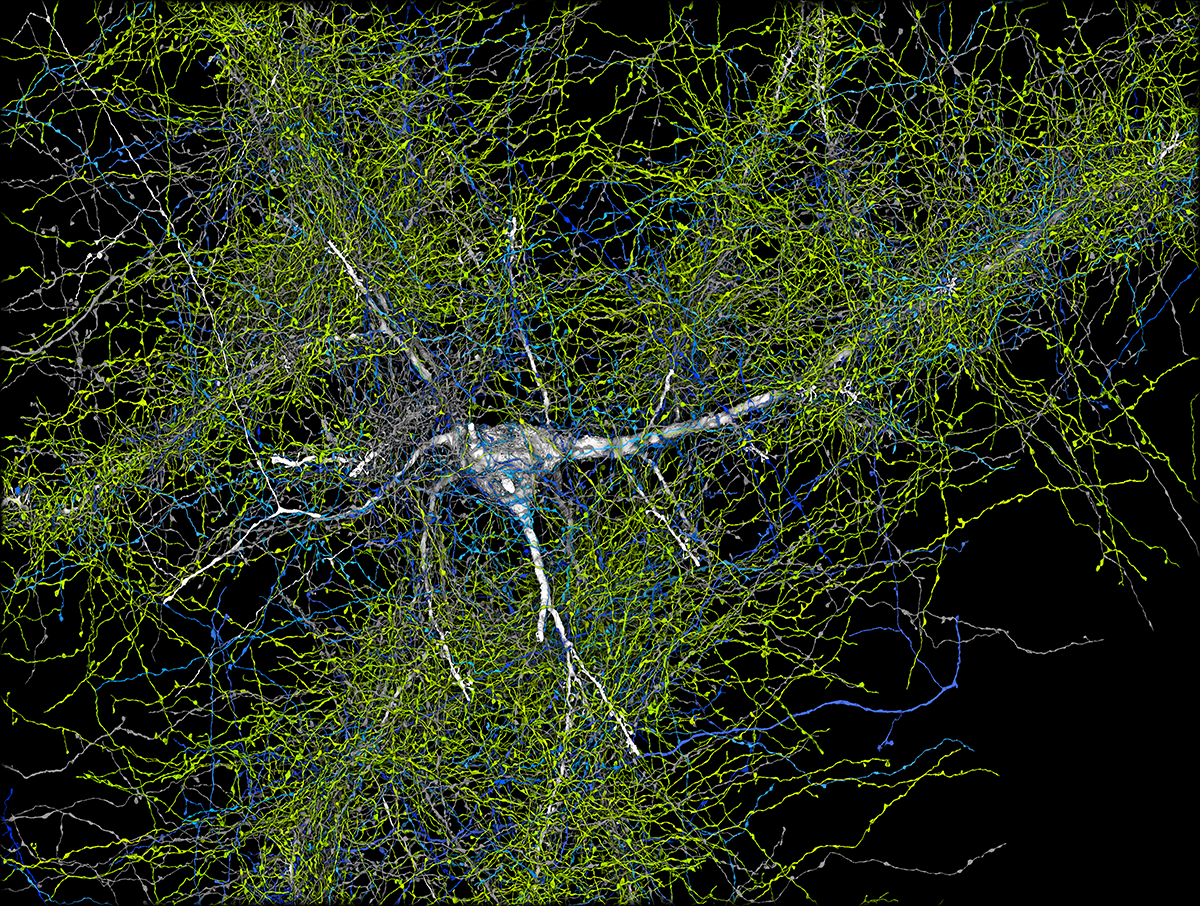
See the most detailed map of human brain matter ever created
The segment’s neuron density is 16,000 neurons per cubic millimeter– about one-third lower than a previous density estimate of the same brain section and 10 times less dense than the corresponding section of a mouse’s brain, per the study. Glial cells, the connective glue that keeps brain tissue together, outnumber neurons in the fragment by a two to one ratio.
Neural explorers
The physical size of the brain fragment may be teeny, but the level of detail means the data captured by the mapping effort is massive. The reconstructed segment is 1.4 petabytes in digital size, or 1,400 terabytes (equivalent to the storage capacity of about 2,800 average laptops). Within that, there is lots to potentially discover: individual neural circuits, previously unobserved cellular ratios and shapes, the makeup of each cortical layer, and more.
“It’s like being an explorer that lands on a new island,” says Lichtman. “You keep looking around and you’re just going to keep finding new things.”
Already, Lichtman and his many co-researchers have made some interesting observations. Amid the ~150 million synapses they mapped, they found a rare type of particularly strong connection. In the vast majority (96.5%) of cases, axons–the outgoing transmission line of neurons– formed one connection with a target cell. Some (about 3%) made 2 connections. But less than .01% forged more than four synapses, including some axons and target cells that were connected at over 50 points.
An image of an axon (blue) climbing up a spiny dendrite (green), establishing an extraordinarily strong connection between an axon and its target cell. Credit: Google Research & Lichtman Lab (Harvard University). Renderings by D. Berger (Harvard University)
“We’ve always had a theory that there would be super connections, if you will, amongst certain cells,” says Mosca. “But it’s something we’ve never had the resolution to prove…Now we know that it exists and we can go after the question of what it does.” Lichtman’s current hypothesis is that these extra-fortified connections are the sort of hyper-fast pathways that enable “automatic use of the brain” for well-established, learned actions.
Another new observation: many dendrites (the branching extensions of neurons that generally receive inputs) seem to mirror each other–pointing symmetrically in one of just two directional arrangements out of infinite three-dimensional possibilities. “We’d never seen anything like that [before],” says Lichtman. “Why are they doing that? We don’t know… [it is] a complete mystery.”
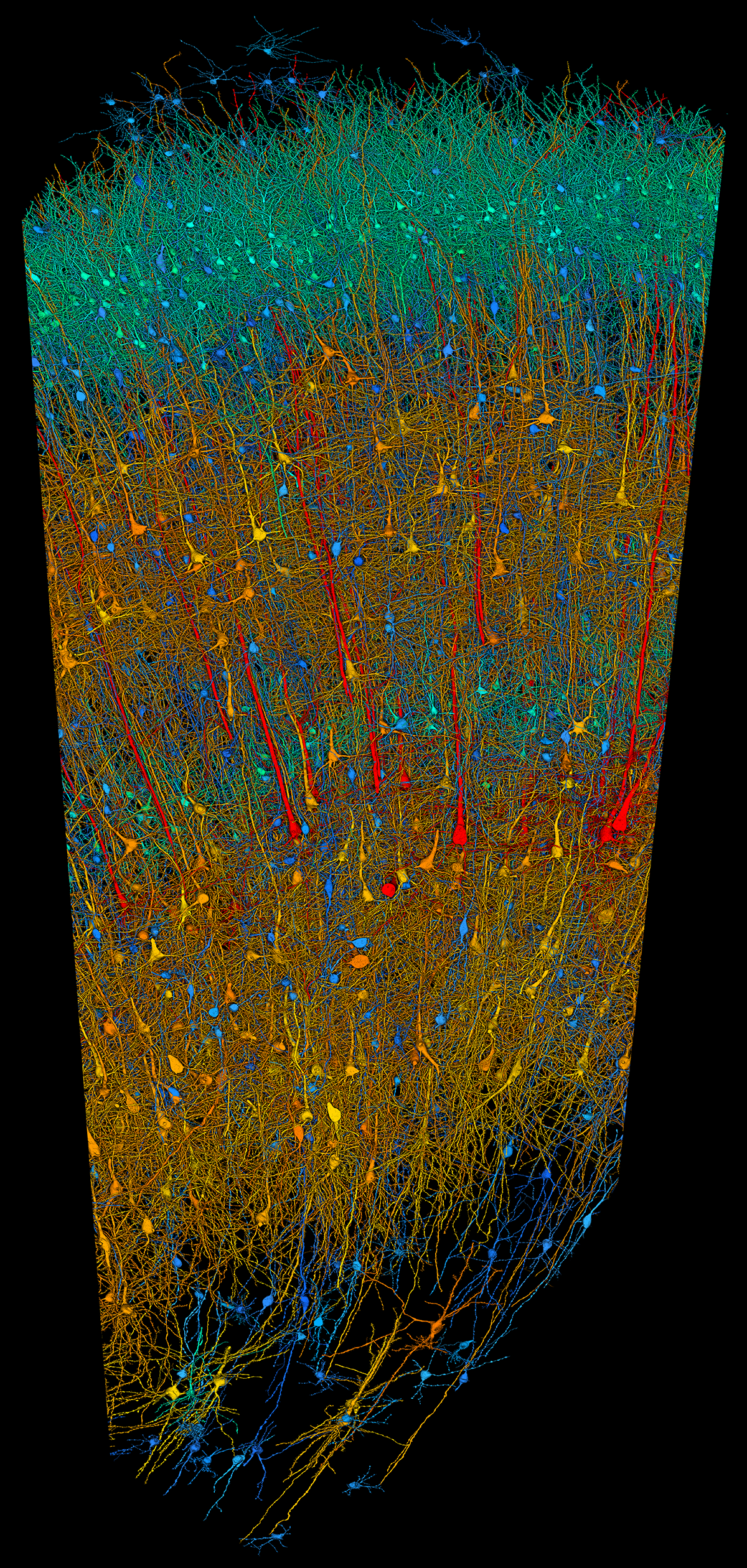
See the most detailed map of human brain matter ever created
An intriguing finding in the reconstruction was the existence of clusters of cells that tended to occur in mirror-image orientation to one another. This image shows a particularly symmetric pair. Credit: Google Research & Lichtman Lab (Harvard University). Renderings by D. Berger (Harvard University)
The scientists further found a new type of unexplained structure that they’ve named an “axon whorl,” wherein long axon cables appear to tangle around themselves. Though it wasn’t every neuron, some axons contained multiple knots, says Viren Jain, co-senior study author and a senior staff scientist at Google where he leads the company’s Connectomics research team. Again, the function and cause of these whorls is unknown. “We were not expecting to find such a structure. It’s very peculiar… like a big jumble of wiring that sort of contravenes the purpose of a wire to begin with, which is to go places and contact other things.”
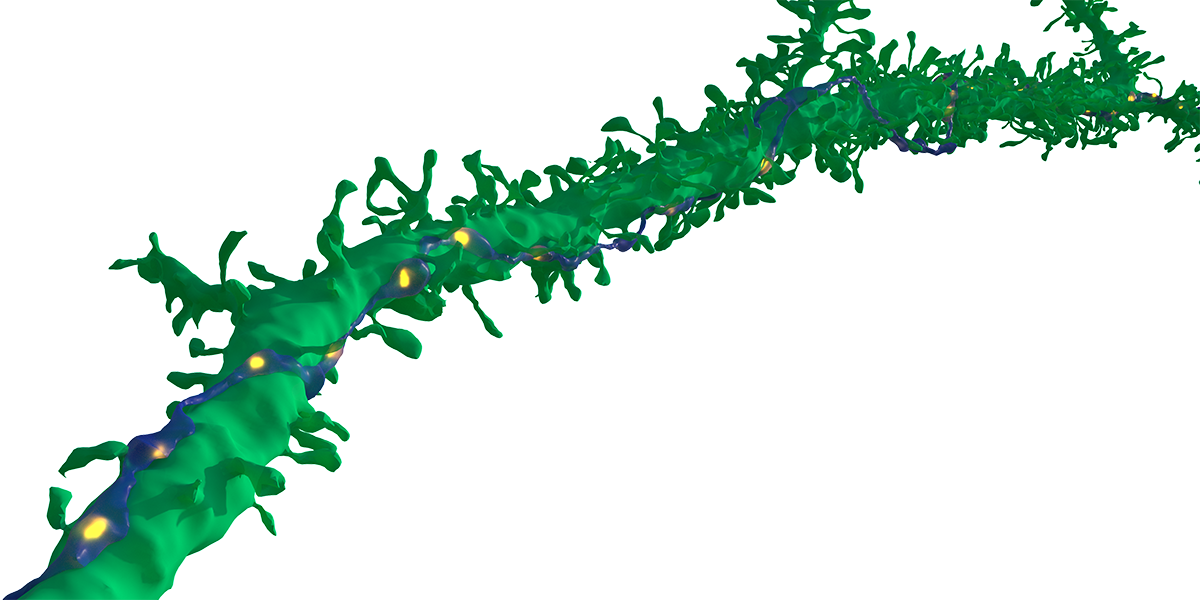
See the most detailed map of human brain matter ever created
surprising finding in this research was the occurrence of “axon whorls”. Axons (blue) are the filamentous part of a nerve cell that carries a signal away from the cell. These looped piles of axon were rare in the sample, and in some cases they sat on the surface of another cell (yellow). Their function is unknown. Credit: Google Research & Lichtman Lab (Harvard University). Renderings by D. Berger (Harvard University)
These three findings are likely just the tip of the iceberg. “The data set is so large that one human being or lab group can not explore it [all], but a bunch of human beings can,” Lichtman says. Because of the open nature of the project, more than 200 papers have cited the brain reconstruction since it was first released as a pre-print, Jain points out.

See the most detailed map of human brain matter ever created
In addition to being a large, fundamental advance in science, discoveries resulting from this partial connectome could eventually help us better understand and treat brain diseases. “The ability to measure neural wiring of human brains in such detail opens up exciting opportunities for advancing human health,” says Andrew Leifer, a physicist and neuroscientist at Princeton University who wasn’t involved in the project. “One could imagine comparing different brains to understand how brain wiring changes when a healthy brain suffers from a disease or falls into dysfunction,” he adds.
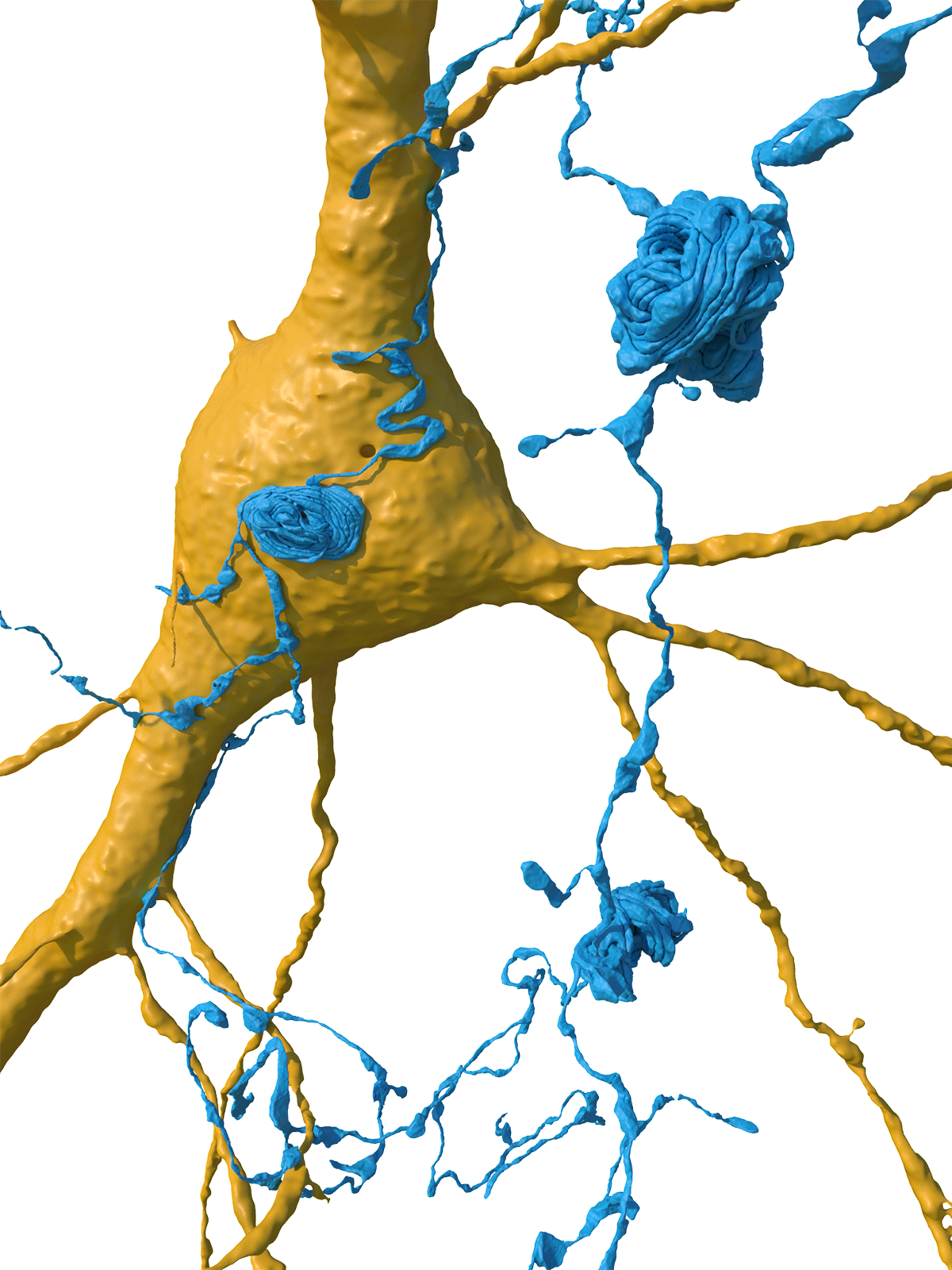
See the most detailed map of human brain matter ever created
Pushing into future frontiers
But though there is lots to be discovered, there are also limits. The automated machine learning methods which were key to enabling such a large-scale endeavor carry a margin of error that requires human oversight to correct. Editing will be an ongoing project, and is a community science effort anyone who wants to can apply to participate in.
The sample is also only one small piece of one person’s brain. There is much that can’t yet be inferred about human brains generally or other brain regions beyond the temporal lobe based on this single fragment without more samples and maps for comparison, notes Lichtman.
This rendering shows all of the excitatory (pyramidal) neurons in a part of the brain sample, at varying degrees of magnification and tilt. They are colored by size; the cell body (central core) of the cells ranges from 15-30 micrometers across. Credit: Google Research & Lichtman Lab (Harvard University). Renderings by D. Berger (Harvard University)
And, perhaps most critically, the brain segment came from someone undergoing surgery for epilepsy–it may not represent a “normal” brain and there’s no way to know for sure unless and until we have more bits to assess, say Jain and Lichtman. “But we are planning many follow-ups to this,” Jain adds.
The team has ambitions to construct multiple partial connectomes representing additional human brain samples. They are also working on zebrafish connectome, and are planning to tackle increasingly large segments of the mouse brain. Mammalian brains share many similarities, so a complete mouse connectome could offer new insights into our own brain as well as the evolution of brains across animals, Lichtman says.

See the most detailed map of human brain matter ever created
At the moment, with currently available technologies (and the ethical implications), a complete connectome of the human brian is “a bridge too far,” says Lichtman. “Literally, we’re a million times away from that,” says Jain. But through this study, the scientists have taken an early (if miniscule) step in that direction, and even the smallest peephole can be a portal into a whole universe of knowledge.
“I would love people to think about this the same way they think about the Hubble or James Webb telescope,” says Lichtman. “We’re peering into an unknown domain, and one that is much more relevant to us than distant outer space. It’s this inner space that each of us have on our shoulders that we use, but know almost nothing about.”
Articles may contain affiliate links which enable us to share in the revenue of any purchases made.
